 Artetsu Saria 2005
Artetsu Saria 2005
Arbaso Elkarteak Eusko Ikaskuntzari 2005eko Artetsu sarietako bat eman dio Euskonewseko Artisautza atalarengatik
 Buber Saria 2003
Buber Saria 2003
On line komunikabide onenari Buber Saria 2003. Euskonews y Media
 Argia Saria 1999
Argia Saria 1999
Astekari elektronikoari Merezimenduzko Saria

Joseba Felix TOBAR-ARBULU
Abstract. We deal with our third experiment about the tracking of the Scolopax rusticola. As in the previous experiments, the point is to know the Eurasian woodcock’s migration along the Western Palearctic.
The first two projects fixed the beginning of a new era in the knowledge of that migration. It was the first time that such experiments were made in Europe with this kind of birds, due to their small weight and their very special behavior.
In these projects (first with 12 gram Solar PPTs in 2006; second with 9.5 gram Solar PTTs in 2007) we have real problems with interferences.1 (As a result, we thought that one possible way to overcome the interferences could be to increase the charge of the PTTs.)
In March 2008, MTI gave us two new prototypes (9.5 grams) equipped with a new technology, to try and prove them.
Here some clear consequences of the use of this new technology during 2008:
a) The charge has been greater than in our previous experiments.
b) The emissions’ data given by Argos have been much better in quality and quantity.
c) The frequency of the emissions has been more regular than before.
d) The frequency has been broken only in very few occasions, when clearly there were no interference problems. So, as hypothesis, we have tried to link this phenomenon with the woodcocks’ roding or croule.
The final result is net: the European interferences have been overcome with both PTTs, during all the time the tracking lasted and in all the different atmospheric circumstances.
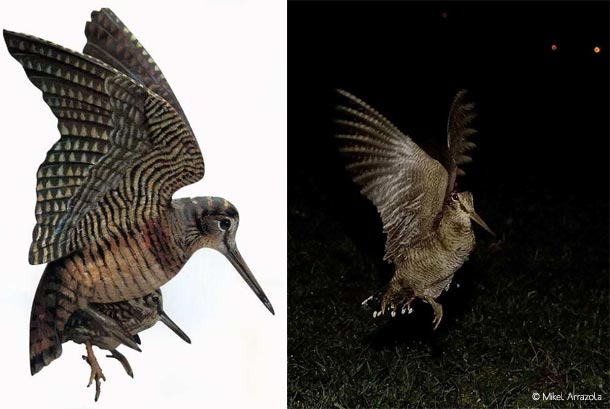

Foto: Ibon Telletxea.

Foto: Zarbo Ibarrola.
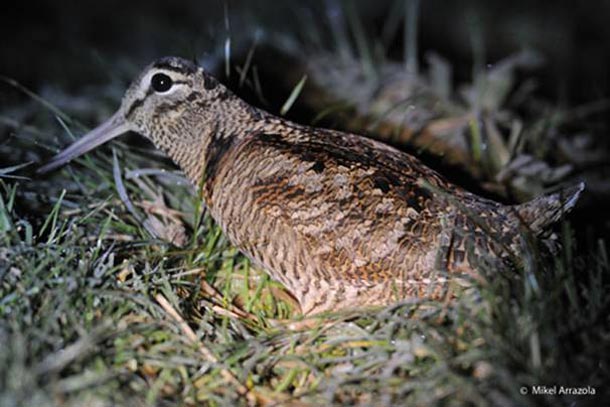
Foto: Mikel Arrazola.
We started our project in 2003. At that time there were no available PTTs for the Eurasian woodcock.
In 2004 we analyzed all the information that was available in internet. At the end of 2004 we knew that MTI was preparing new solar PTTs of 12 grams.
We did know that some woodcocks were equipped with transmitters of 12 grams,2 for traditional telemetry tracking.
So, at the beginning of January 2005, wecontacted MTI.
We sent MTI some information about our project:3
We also sent MTI some characteristics4 of the Scolopax rusticola:
Habitat: Moist, early-success ional woodlands near open fields or forest clearings; abandoned fields, brushy forest openings, wooded edges of streams and ponds, brushy edges of open swamps.
Habitat requirements: (a) Clearings for courtship displays and nighttime roosting. (b) Areas of soft, moist soil containing earthworms and with overhead cover. (c) Young, open woodlands for nesting.
Diet: Earthworms (staple); insects, especially larvae of beetles and flies; spiders, millipedes, snails; some seeds and berries.
In order to track its migration (from September-October until the middle of November) we should have to take in consideration some problems:
a) It is time for its hunting, so lot of problems to survive.
b) The bird uses brushy forest to protect itself.
This is why we would prefer to follow it in its counter migration, from the Spanish state to its breeding areas (maybe up to the Ural Mountains).
The counter migration has some advantages:
1) The bird goes right away to its breeding areas.
2) It does not use as much the brushy forest as it uses in its migration.
3) There is no hunting.
The counter migration period is a short one: the bird leaves the Spanish state around the middle of March and in a couple of weeks all, or at least most of the birds are gone.
All the above makes our project easier in the counter migration than in the migration period.
Here some more points to take in consideration:
(I) In its longest trip, it will go from the north of Africa up to the Ural Mountains, kind of 5,200 Km, and in the even longest trip around 5,500 Km.
(II) The bird flies by night. During the day the bird rests in places where there is no much light.
(III) After reaching its breeding area, if female she will rest and try to make its nest. If male, he will be roding.
(IV) From April to September-October the bird does not fly long trips.
(V) From September-October on, there will appear the problems we mention above about the migration; the worst of all will be that the hunting period will be open.
In principle, we will try to follow the bird up to its death.
On March 1st, 2005, we sent MTI an e-mail with the following decision:
a) We are planning to follow the counter migration of the Scolopax rusticola starting next March, 2006.
b) So, we will need (some) PTT-100 12 gram Solar PTTs to be in our hands by next January, 2006.


(Palearctic).

(Western Palearctic).

(Eurasian woodcock´s area in Europe, Snow and Perrins).
Yelow: the strict breeding area.
Blue: Strict winter area.
Green: breeding and winter area.
Trasgu: Scolopax rusticola without frontiers

(Trasgu´s track, days).

(Trasgu´s track, distances).

(From Catalonia towards the Northeast).
Interferences.
We used two kinds of PTTs: one PTT-100 12 gram Solar PTT, duty cycle 48/10; and two with duty cycle 72/10.
Some results:
a) Few emissions up to Russia
b) The Catalonian bird went into the interference-hole
c) Trasgu was in her possible nest from May 27th to June 16th without emitting. (This is why we think the bird was a female.) After that, the bird disappeared.
d) We were aware of the problem of the interferences in Europe.
We did know that in 2006 MTI were developing 9.5 gram Solar PTTs.
Scolopax rusticola without frontiers


(Astur´s track, days).

(Astur´s track, distances).


(Navarre after her release).

(Navarre´s track, days).

(Navarre´s track, distances).
We used two kinds of PTTs: one PTT-100 9.5 gram Solar PTT, duty cycle 48/10 and transmission interval of 60 seconds (Astur); and the other one with duty cycle 48/10 and transmission interval of 45 seconds (Navarre).
Some results:
a) Very few emissions up to Russia
b) Astur went up to the Ural Mountains
c) Navarre was nesting during some days
d) Inside Russia Navarre’s PTT (transmission interval of 45 seconds) gave better emissions than Astur’s PTT (transmission interval of 60 seconds)
e) The PTT we used in 2006, 12 gram solar PTT, duty cycle 48/10, gave much better emissions, in quality and quantity
f) Inside Russia, the PTT we used in 2006 gave more regular emissions than the new ones, the frequency of the emissions was much better
g) The charge of the PTTs is the key point, not only against interferences but also to give better emissions
h) So, in new projects the PTTs would have to charge more
i) The problem of the interferences is really serious, hard and deep We were able to determine the location accuracy of some class A and B locations.5
First time that we think about the possibility of going up to the Ural Mountains and release there a couple of woodcocks, one at each side of the mountains to track them.
Following MTI’s guides, the CCB has been tracking woodcocks during the last two years. Navarre is a young woodcock we caught in Bakaiku (province of Navarre on March 2007); the bird is a female (known by genetic analysis). Navarre went up to Russia, came back to 11 km from the point she was released (traveling more than 7,600 km).

(Navarre´s position on February 5th, 2008: 11 km from her release point of March 2nd, 2007).
According to some European people in charge of the most famous clubs of woodcock hunters, our Navarre has almost become a kind of mythological hero.

(Navarre´s whole way from March 2nd 2007 to February 5th 2008).
We did know about the woodcock’s habitats and habits. In this particular case, Navarre has proved that she has come back right to her winter resting place, the beautiful beech grove of Aralar.
More than that, in order to reach her winter place to stay resting, she has had to come along very different places where the hunting period was opened: many different European regions with hunters everywhere. This is why some European fellows have defined her as iron woodcock.
Being female, almost a mythological hero, and, above all, an iron woodcock, some friends of ours wish this bird had lots of chickens, just to give them her biological strength and her intuition, so that her chickens could be also able to solve all these dangerous obstacles.

Long live Navarre!
As William Shakespeare wrote, “Navarre shall be the wonder of the World”.
We have already dealt with Navarre as the iron woodcock.6
But this wonderful woodcock continued her journey, second time, to Russia. She was in Russia after traveling around 11,425 km.
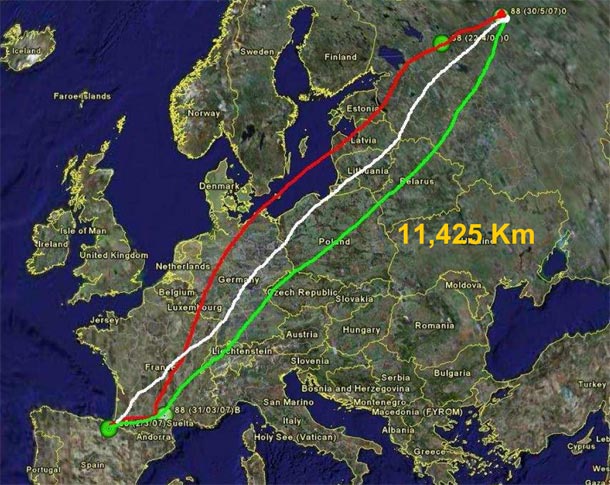
(Navarre´s whole way from March 2nd 2007 to Gebruary 5th 2008 to May 6th 2008).
More than that, she was nesting again: around 2.8 km from last year’s nest:

(Navarre on May 30th, 2008, nesting: 2.8 km from last year´s nest).
So, we have redefined her: from now on, she is and always will be the golden woodcock.

(Golden woodcock with diamond eyes).

(Golden woodcock with diamond eyes).

(Golden woodcok with emerald eyes).
As William Shakespeare would say,7 “Navarre is the wonder of the World”.

(Navarre with her PTT after the release, at nigh: March 2nd, 2007).
Since last August, 2008, we have no news from Navarre. But let us wait... Who knows?

(Golden woodcock with diamonds and cabochon sapphire eyes).
Scolopax rusticola without frontiers:new technology
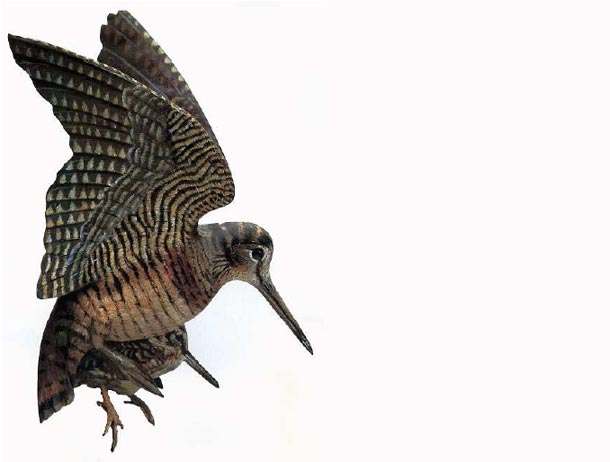
In this third project we deal with two prototypes8 given by MTI.

As in our two previous projects,9 migration is the subject. Once again, this Scolopax rusticola’s tracking is the first done in Europe with this kind of PTTs.
The PTTs have a special duty cycle of 55/8. One of the main aims of this project is to see the performance of the new PTTs against the European interferences. Another one, of course, is to know the migration of two Eurasian woodcocks: Araba and Laguna.
On March 8th, 2008, Laguna10 was caught in Legutio (Araba, Basque Country). After putting the PTT, Laguna was released (43º 00’ 02, 27’’ N 2º 39’ 37’’ W). Laguna is male, young, his weight is 385 grams.

(Laguna before his release).



(Laguna with his PTT).

(Laguna´s release point).

(Laguna after his release).
On March 10th, 2008, Araba was caught in Lukiano (Araba, Basque Country). After putting the PTT, Araba was released (42º56’05.38’’ N 2º50’38.97’’ W). Araba is male, young, his weight is 335 grams.


(Araba before his release).

(Araba with his PTT).

(Araba´s release point).

(Araba after his release).
In both cases, the tracking of the two woodcocks has had three different stages: (a) the movements around their release point before crossing the Pyrenees; (b) from the Pyrenees up to Russia; and (c) the movements inside Russia.
a) Movements around the release point
(1) Data given by Laguna
After his release, Laguna gave the following data:
In March:
8th (B location), 12th (Z loc. with coordinates), 14th (1 loc.), 17th (Z loc.), 22nd (1 loc.), 25th (0 loc.), 27th (0 loc.), 30th (0 loc.).
In April:
2nd (B loc.), 4th (A loc.).

(Laguna´s locations around his release point: Legutio, Araba, Basque Country).
(2) Data given by Araba
In March:
10th (1 location), 12th (B loc.), 14th (2 loc.), 16th (1 loc.), 19th (2 loc.), 21st (B loc.), 24th (A loc.), 26th (Z loc.), 29th (Z loc.).
In April:
1st (0 loc.), 3rd (2 loc.), 6th (A loc.), 11th (B loc.), 16th (A loc.).

(Araba´s locations around his release point: Lukiano, Araba, Basque Country).
b) Data from the Pyrenees up to Russia
(1) Data given by Laguna
In April:
7th (0 loc., in France), 9th (0 loc.), 12th (2 loc.), 15th (0 loc., in Lithuania)11, 17th (Z loc.).
(2) Data given by Araba
In April:
19th (1 loc., in France), 21st (1 loc.), 24th (2 loc., in Germany), 26th12 (2 loc.), 29th (A loc., in Sweden).
In May:
1st (0 loc.), 4th (A loc., in Estonia).
c) Data in Russia
(1) Data given by Laguna
In April:
20th (B loc.), 22nd (A loc.), 25th (0 loc.), 28th (B loc.), 30th (0 loc.).
In May:
3rd (0 loc.), 5th (A loc.), 8th (A loc.), 10th (A loc.), 13th (0 loc.), 16th (A loc.), 18th (A loc.), 21st (B loc.), 23rd (0 loc.), 26th (0 loc.), 29th (B loc.), 31st (A loc.).
In June:
3rd (A loc.), 6th (A loc.), 8th (B loc.), 13th (B loc.), 16th (1 loc.), 19th (A loc.), 21st (0 loc.), 24th (B loc.), 29th (A loc.).
In July:
2nd (A loc.), 4th (Z loc.), 10th (B loc.), 13th (B loc.), 15th (2 loc.), 18th (B loc.), 20th (B loc.), 23rd (0 loc.), 26th (B loc.), 28th (A loc.), 31st (Z loc.).
5th (A loc.), 8th (B loc.), 10th (Z loc.), 16th (Z loc.), 24th13 (Z loc.).
Laguna has gone up to the surroundings of Elizarovo,14 in Kostroma.
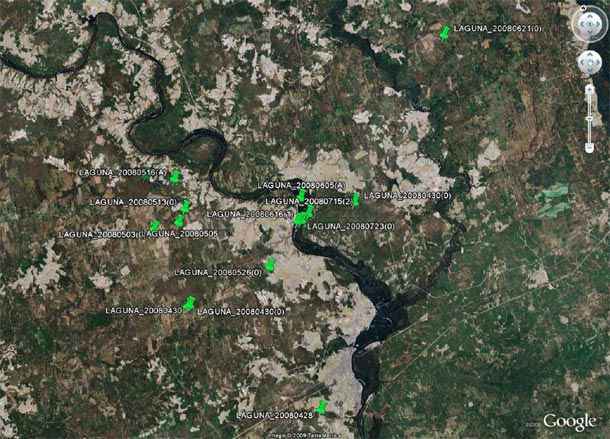
(Locations given by Laguna in Russia).
After that emission (on September 24th), Laguna gave no more datum. On December 27th was hunted at Legutio, at 454 meters from his release point.
How is it that his PTT gave no datum at all?
Laguna’s weight when we caught him, before his release: 385 grams. Laguna’s weight when he was hunted: 300 grams. This decrease is normal, since the bird traveled from Russia and crossed the whole Europe.
But this decrease does not explain the fact that his PTT gave no datum. In spite of some possible looseness of the harness, the PTT could have been charged and, therefore, it could have emitted.

(Laguna Dead).
Despite his death, Laguna has also become an Iron woodcock. He has been able to come back to the same place where we caught him, crossing Europe while the hunting period was open.

(454 meter from the release point to the hunting-point).
(2) Data given by Araba
In May:
6th (0 loc.), 9th (1 loc.), 12th (B loc.), 14th (A loc.), 17th (1 loc.), 19th (0 loc.) 22nd (1 loc.), 24th (2 loc.), 27th (1 loc.), 29th (A loc.).
In June:
1st (A loc.), 4th (Z loc.), 6th (3 loc.), 9th (0 loc.), 11th (A loc.), 14th (2 loc.), 16th (A loc.), 19th (1 loc.), 21st (A loc.), 24th (2 loc.), 27th (3 loc.), 29th (2 loc.).
In July:
2nd (1 loc.), 4th (0 loc.), 7th (A loc.), 9th (0 loc.), 12th (2 loc.), 14th (2 loc.), 17th (3 loc.), 20th (A loc.), 22nd (3 loc.), 25th (A loc.), 27th (1 loc.), 30th (A loc.).
In August:
1st (B loc.), 4th (3 loc.), 7th (A loc.), 9th (1 loc.), 12th (B loc.).
After being one month without emitting,15 here the data of September:
14th (1 loc.), 22nd (Z loc.), 24th (Z loc.), 27th (B loc.), 29th (Z loc.).
In contact with MTI, we tried to follow the emissions of that PTT, in order to try and recover it.
The PTT gave some data16 in October:
2nd (Z loc.), 7th (A loc.), 17th (Z loc.), 20th17 (Z loc.)
Araba has gone up to the surroundings of Rantala,18 Republic of Karelia.

(Locations given by Araba in Russia).
From September 14th on, in all the different emissions the activity sensor has not changed: the bird is dead and/or his PTT is detached.

(Location of Araba´s PTT).
d) Tracks
(1) Laguna’s track

(Laguna´s track, days).

(Laguna´s track, distance).
Laguna’s whole track is around 3,710 km.
(2) Laguna: Iron woodcock
As mentioned before, in spite of his death, Laguna has become an Iron woodcock. He has been able to come back to the same place where we caught him, crossing Europe while the hunting period was open. All in all, his whole track has been around 7,420 km.
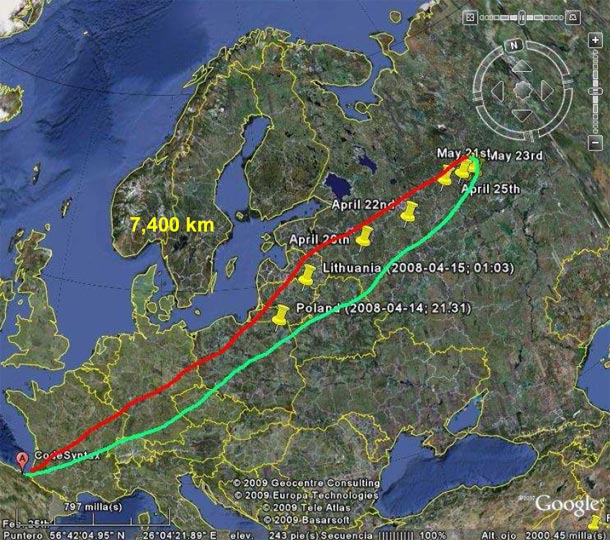
(Laguna´s whole track from March 8th, 2008, to December 27th: around 7,400 kilometers).
(3) Araba’s track
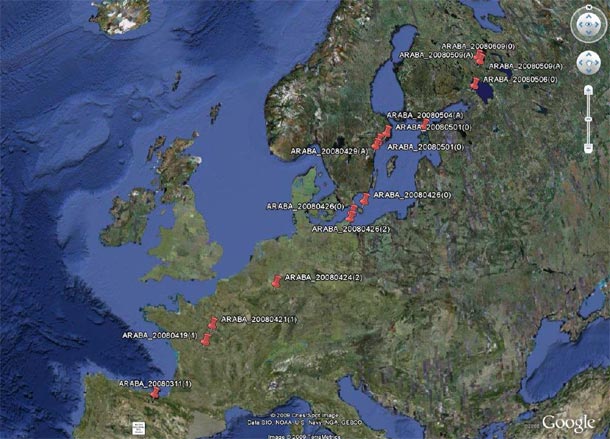
(Araba´s track, days).

(Araba´s track distance).
Araba’s whole track is around 3,280 km.
e) Some conclusions
Here some different kinds of conclusions: (a) related to locations; (b) related to the speed of flight of the birds; (c) related to the resting periods during the track; (d) related to the duty cycle; (e) related to the roding or croule; (f) related to the interferences; and (g) related to the global results.
(a) Locations
Laguna and Araba have given a lot of locations, but not very continued in time so that we can measure the accuracy (and the errors) of class B and A locations.
On March 16th, Araba gave a class A location that can be measured, if we take into account that the period between that class A location and the previous class 1 location was 4.5 minutes, too much time.
In this occasion, we have used a new methodology: to the result that can be gotten from the previous methodology19 we have added, in the worst hypothesis, the space that the bird could travel in those 4.5 minutes.
According to the new methodology,20 the accuracy of that class A location is of 5.8 km. (In 2007, the accuracy of the class A locations given by Navarre and her PTT were between 1.77 and 5.65 km.)
Again, this is what we would like to underline: class A and B locations are very important for our woodcocks, since they are real and objective. To know the accuracy of these locations, we do have a good, clear and precise methodology.21
(b) Speed of flight
Laguna:
On April 14th, Laguna went from Poland to Lithuania (294 km) at night (from 21:31 to 01.03, UTC) given two emissions. So, his average speed of flight was 84 km/h.
Araba:
On April 26th, Araba in his way from Germany to Sweden crossed the sea at night (from 20:18 to 21:56, UTC) given two emissions to travel 108 km. So, his speed of flight was 66 km/h.
(c) Resting periods
Laguna:
Laguna was resting in France five days.
Araba:
Araba was resting in Sweden two days.
(d) Duty cycle
As we have said, these PTTs have a special duty cycle of 55/8. As a conclusion of our previous two projects, we underlined that for future projects, to overcome the interferences, and with the ‘old’ PTTs, the duty cycle should have to be of 72/10. If we compare the ‘old’ and new PTTs, it seems that the new ones’ (with the old nomenclature) duty cycle is of 69/10. The point is that the new PTTs use a new special technology.22
Taken into account the data from our previous two projects and the data from this project, here some clear consequences of the use of this new technology during 2008:
a) The charge of the PTTs has been greater than in our previous experiments.
b) In each emission per day, Argos has given more locations this year than in the previous two years.
c) The emissions’ data given by Argos have been much better in quality23 and quantity.
d) The frequency of the emissions has been more regular than in the two previous projects.
e) The frequency has been broken only in very few occasions, when clearly there were no interference problems. So, as hypothesis, we have tried to link this phenomenon with the woodcocks’ roding24 or croule.
f) The problem of the interferences has been overcome with high charge, as we proposed in our previous experiments.
(e) Some notes on roding or croule
Laguna and Araba have been ‘missing’ during some few days, when they were in Araba (Basque Country) and in the breeding zone. Were they roding? Mating females?
Can be related those missing days to mating after roding? It is really difficult to give a right answer, but we will try to see all these ‘missing’ days, and, as hypotheses, try to relate those data with possible mating periods.25
(a) Laguna’s data (young woodcock):
While Laguna was in Araba (Basque Country) the bird was missing during the following dates:
March 17th to March 22nd.
While Laguna was in Russia, here his missing days:
From June 8th to June 13th; from June 24th to 29th; from July 4th (LC Z location) to July 10th; from July 31st (a LC Z location) to August 5th and from August 10th (a LC Z location) to August 16th (two LC Z locations) and then to August 24th (a LC Z location)26.
(b) Araba’s data (young woodcock):
While Araba was in Araba (Basque Country), here the dates when the bird was missing:
March 29th (a LC Z location) to April 1st. From April 6th to April 11th and then from April 11th to April 16th.
While Araba was in Russia, the bird was no missing.27
Again, we must underline that all these data are related to dates where the birds were missing. Missing to mate females?
Taking into account the specific technological characteristics of these two PTTs, which are able to be charged in very difficult environments, it can be plausible that during the above mentioned dates28 both birds could have been first roding and then mating females.
(f) Interferences
It is true that there are interferences around the Mediterranean Sea. In our two previous projects there was no way to localize the birds in different places of Europe and during long periods of time.
It is clear that MTI and Argos did know that problem.29 This is why Paul Howey (of MTI) wanted to check two prototypes in Europe and with woodcocks:
(a) To know whether these prototypes charge better or not.
(b) To know if these new PTTs charge well with such a special bird as the woodcock is (moving in special spaces, traveling at night, and so on).
(c) To know the performance of these new PTT against the European interferences. (We do know that in order to overcome the interferences the PTT’s charge is the main variable.)
The final result is net: the European interferences have been overcome with both PTTs, during all the time the tracking lasted and in all the different atmospheric circumstances.30
(g) Global results
Here what can be said about our third project:
(1) With reference to the weight of the PTT and to the weight of the bird, this is the first experiment done in the whole world.
(2) Using these kinds of PTTs, this is the first experiment in the whole world made with woodcocks.
(3) We can make the same questions as we did before: Do the woodcocks cross the Ural Mountains? Where do the woodcocks which are in the other side of the Ural Mountains go in their migration? In what direction do they travel? How far?
F. Last words
Is it possible to gather even more data? To gather even more accurate data? We will keep working, researching, trying to know more about the migration of the Scolopax rusticola and to gather data with more frequency and better accuracy, always following the advices of MTI.
Bibliography
Duriez, O. (thesis, 2003), Stratégies individuelles d’hivernage chez la bécasse des bois (Scolopax rusticola): compromis énergétiques pour la sélection de l’habitat (http://tel.ccsd.cnrs.fr).
Fadat, C. 1995. La bécasse des bois en hiver. Ed. C. Fadat, Clermont-1’Hérault.
Hays, G.C. et. al. (2001) The implications of location accuracy for the interpretation of satellite-tracking data, Animal Behaviour, 61 (5):1035-1040.
Lucio, A.J. and M. Sáez de Buruaga (2000) La becada en España. Federación Española de Caza y Fedenca.
Show D. C. and C. Perrins (1998) The birds of Western Palearctic - (Concise edition), Oxford: Oxford University Press.
Vincent, C. et al. (2002) Assessment of Argos location accuracy from satellite tags deployed on captive Gray Seals. Marine Mammal Science, 18 (1), 156–166.
Acknowledgments
This work is based on the different projects performed by the CCB (Club de Cazadores de Becadas) since 2006 up to 2008. The projects have been sponsored by the Government of Navarre (2006, 2007, 2008), the Government of Catalonia (2006) and Microwave Telemetry Inc (MTI) (providing two prototypes with a new technology in 2008); also by the CCB itself (in all these years).
Here some of the people we would like specially to thank:
(a) The Navarrese team (Isabel Leranoz, Alfredo Beloki and Jose Inazio Urriza) and the Araba team (brothers Asier and Rubén San Vicente, Josu Salazar, Victor Regueiro, Javier Uriarte and Ikatz Pérez de Arriba).
(b) Dr. Charles Fadat and Dr. Nikita Chernetsov gave very helpful information.
(c) Jonathan Rubines used genetic analyses to know the sex of our woodcocks.
(d) The friends of Argos always have been ready to help: Maura Massana, Anne Marie Breonce, Aline Duplaa and Bill Woodward.
(e) Last but not least, special thanks to the whole team of Microwave Telemetry Inc (MTI), to Cathy Bykowsky, and mainly to Paul Howey.
(*) This work is part of a series of different papers done by a team composed by Ibon Telletxea, Mikel Arrazola, Zarbo Ibarrola, Raúl Migueliz, Joakin Anso, Izaskun Ajuriagerra, Ruben Ibáñez, Roberto Gogeaskoetxea, Felipe Diez and Joseba Felix Tobar-Arbulu. The photos were taken by Mikel Arrazola, Zarbo Ibarrola and Ibon Telletxea.
The project in the press
- A First!: (Mistake: instead of 5000 km, it should be read 3000 km.)
- Les Voyages d’Astur et deNavarre, Bécasse Passion, 2007, 62: pp. 16- 22.
- Navarre, suivie par Radio Télémétrie... 760 Km parcourus, Bécasse Passion, 2008, 65, p. 11.
- Trofeo Caza: http://www.trofeocaza.wanadoo.es/trofeocaza/html/carticulos/168279_1.html
- ACCA
- ACCA
- ACCA
- Trofeo: Viajando con nuestras becadas, 2006.11, pp. 64-68.
- Diario de Noticias (Navarra), 2006.11. 17, El viaje inédito de Trasgu.
- Diario de Navarra (Navarra), 2006.11.15, De Etxarri-Aranatz a Rusia.
- La caza y su mundo, 2007.11, Desde Rusia con amor, pp. 27-41.
- Diario vasco, 2007,03.11, El misterio de la becada.
- El Correo digital, 2008.08.28, Un viaje de 3000 Kilómetros.
- Todo becada, 2008, Seguimiento de becadas mediante radiotelemetría vía satélite, pp. 14-21.
- Basque TV (ETB-1, 2008, in Basque joseba; ETB-2, 2007, in Spanish Raúl)
- Basque Radio (2008, in Basque joseba; 2008, in Spanish joseba)
- Canal Caza y Pesca. Programa ‘Veda Abierta’ (2008, Ibon)
1 See http://www.microwavetelemetry.com/newsletters/winter_05page8.pdf and http://www.microwavetelemetry.com/newsletters/spring_06page8.pdf.
2 See Duriez’s thesis (2003).
3 The first e-mail was sent on January 7th, 2005.
4 Our dear Cathy (MTI) asked for that information.
5 See Location accuracy of emissions gathered via satellite.
6 See MTI’s Newsletter.
7 Actually this is what Shakespeare wrote: “Navarre shall be the wonder of the world”.
8 The special characteristics of these new PTTs will be explained by Paul Howey in the 2009 MTI Conference.
9 About the first project, see
http://www.euskonews.com/0380zbk/gaia38002eu.html
and
http://www.euskonews.com/0383zbk/gaia38302eu.html
in Basque; and
http://www.euskonews.com/0380zbk/gaia38002es.html
and
http://www.euskonews.com/0383zbk/gaia38302es.html
in Spanish. About the second project, see http://www.euskonews.com/0431zbk/gaia43102eu.html
and
http://www.euskonews.com/0433zbk/gaia43302eu.html
in Basque; and
http://www.euskonews.com/0431zbk/gaia43102es.html
and
http://www.euskonews.com/0433zbk/gaia43302es.html
in Spanish.
10 The name Laguna is our small tribute to Paul Howey, to show him our friendship. Laguna means friend in Basque.
11 Laguna went from Poland to Lithuania (294 km) at night (from 21:31 to 01.03, UTC); his average speed was 84 km/h, maybe with the help of some kind of wind.
12 Araba in his way from Germany to Sweden crossed the sea at night (from 20:18 to 21:56, UTC); to travel 108 km, his speed was 66 km/h.
13 This was the last emission given by Laguna.
14 See. (Use the zoom.) See also .
15 How is it that the PTT has not emitted during a whole month? In all the different emissions from September 14th on, the activity sensor has not changed. So, the bird is dead and/or his PTT is detached. The last emission given by Araba, while still he was alive, was on August 12th.
16 In all these data the activity sensor was without changing.
17 This was the last emission given by Araba’s PTT.
19 See http://www.euskonews.com/0433zbk/gaia43302eu.html and http://www.euskonews.com/0433zbk/gaia43302es.html. See also Location accuracy of emissions gathered via satellite.
20 See Location accuracy of emissions gathered via satellite.
21 See http://www.euskonews.com/0431zbk/gaia43102eu.html, section 7, note 5 and note 18 of this work. As we said in the mentioned work, the accuracy of the locations depends on the pair PTT/bird. This year, in spite of Araba’s PTT and Laguna’s PTT being of the same characteristics, the emissions given by Araba have been much better in quantity and quality than the ones given by Laguna.
22 This new technology will be explained by MTI in the 2009 Conference. Although one of us new about the characteristics of these PTTs, he gave his word to Paul Howey not to say anything about them. These two PTTs are prototypes and we have put them in practice. MTI developed five (5) prototypes to be checked all over the world. The PTTs in our projects are the smallest of them.
23 Araba’s emissions have been better than Laguna’s.
24 See what is said below about roding.
25 See Woodcocks behavior in the breeding season: roding and nesting.
26 Laguna gave his last emission on August 24th.
27 Araba gave his last emission on August 12th, being alive.
28 This does not mean, of course, that these missing days were the only days where the males were possibly mating females. Furthermore, if we consider that the special duty cycle of the new PTTs is 55/8.
30 As MTI people have told us, from now on they will use the same special and new technology our PTTs had in all the new PTTs they will produce.
Comments:
comments powered by Disqus